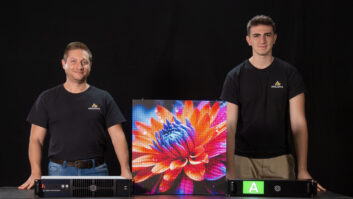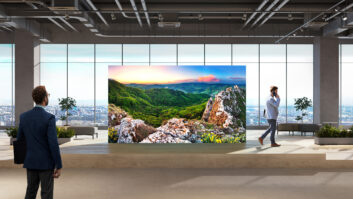
Previously, we took an overview of the current state of screen technology and considered where display technology is heading. Here Ian McMurray looks at the opportunities and concerns surrounding HDR as well as the potential of OLED technology.
It could be said that, for now at least, discussion of pixels is no longer about quantity, but quality.
“After having reached a certain level of resolution and brightness, the next generation of display products will certainly address colours, colour compliance and maybe also higher frame rates,” thinks Tobias Augustin, senior product manager – large format displays, NEC Display Solutions Europe. “In post production or media applications, it is all about colour gamuts and reliable calibration; in healthcare applications, DICOM compliance and image uniformity matter the most.”
HDR – high dynamic range – is capturing significant attention with its promise of deeper blacks, brighter whites and more vibrant colours. “HDR will be interesting for certain applications that need more detailed colours in gradients and so on,” says Max Winck, marketing manager at eyevis. “Designers, especially in the automotive industry, keep asking us for HDR. But: they’ll need specially created content and for the appropriate signal chain to be in place.”
Enrique Robledo, European marketing manager for Panasonic Visual System Solutions, echoes his concerns. “When capturing images and video, the combination of higher resolutions and HDR is opening new horizons and helping produce increasingly life-like displays,” he says. “From the display point of view, the focus in a commercial environment is to provide larger and larger sizes, which means increasing the resolution. The challenge, though, remains in the processing and especially the distribution of the content.”
A technology that is emerging that has the potential to redefine image quality is OLED. The key word here is ‘potential’: the industry is not convinced that it is yet ready for the rigours of commercial installations – and HDR delivers many of the image quality advantages of OLED.
“OLED can provide great image quality for some professional applications even today,” says Augustin, “but limitations like image retention and reduced lifetime will not let OLED enter the mainstream digital signage market within the next few years. LCD is the cheaper and safer choice.”
Unsolved issues
“Thousands of engineers have researched the issues connected with OLED technology for two decades now,” he continues, “but, unfortunately, some issues will not be solved in the near future.”
Walter, notes that, while OLED may not yet be ready for commercial installations, it is “a technology that NEC is following intensely”.
“There is still a lot OLED must improve to challenge LCDs,” echoes Winck, “mainly in terms of lifetime and resistance to image retention. LCD has improved a lot over the last few years, and OLED has much to do to catch up or even overtake it.”
It should be said, however, that the pro-AV industry is widely appreciative of the incredible images of which the technology is capable and believes that OLED has a brighter future near term in the consumer market than the commercial.
And, of course, any discussion of OLED would be incomplete without referring to its light, thin nature which can not only make mounting a display as simple as taping it to a wall, but also makes it possible to create ‘rollable’ screens. It seems inevitable that, eventually, these characteristics will create new display applications – but, at least in the pro-AV field, it’s far from clear yet what those might be.
It becomes apparent, then, that in terms of resolution, brightness and contrast – the primary contributors to image quality – we have as much as we need today. Certainly, efforts to improve it will continue: “The most successful display manufacturers in the next five years will be those who prioritise image quality and the viewing experience,” believes Steve Scorse, vice president, EMEA at SiliconCore – but the thrust of display development may well lie elsewhere.
If shrinkage in LED pixel pitches has caught the eye, so too has shrinkage in bezels. As Suchit Rout, director – global strategic alliances and business development at Barco, points out. “Ultra-narrow bezels in near-seamless LCD display walls to ensure the minimum possible distraction for control room decision-makers have been among the more important developments of recent times,” he says. “You can add to that the advent of automatic calibration that ensures image consistency not only within an individual panel, but across an entire LCD videowall. Remote and redundant power supplies have also become increasingly important.”
Winck believes we will see truly bezel-less displays within a few years, and points out the enormous strides that have been made possible by IP in terms network connectivity and controllability.
Room for improvement
Installability is a recurring theme. As straightforward as displays may be to deploy, there is still room for improvement.
“Every kilo counts for broadcasters installing flatpanels in their outside broadcast vehicles,” notes Thomas Issa, product manager at Sony Professional, “and therefore view slim, weight-saving chassis as a key criterion for their display solutions. The development of thinner, lighter displays throughout the flatpanel market, whether OLED, LED or otherwise, continues to push what is possible with installations, opening up new uses and possibilities for flatpanel displays in the future.”
It’s not just in the perhaps arcane world of outside broadcasting that installability is important.
“By incorporating an inbuilt media player, WiFi capability and a standard Android operating system, we have greatly reduced cabling complexity and eliminated the need for an external player device,” explains Robledo. “This makes it possible to implement digital signage in previously unsuitable locations.”
www.barco.com
www.eyevis.com
www.nec-display-solutions.com
www.pro.sony.eu
www.siliconcore.com
http://business.panasonic.eu







